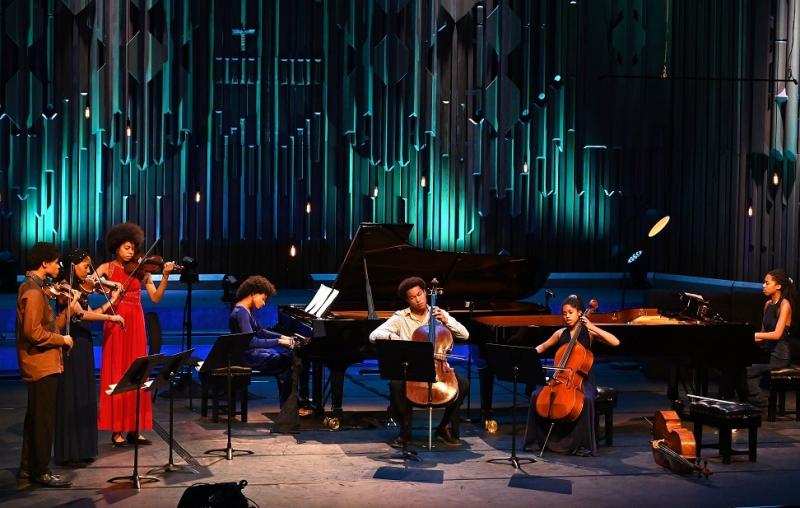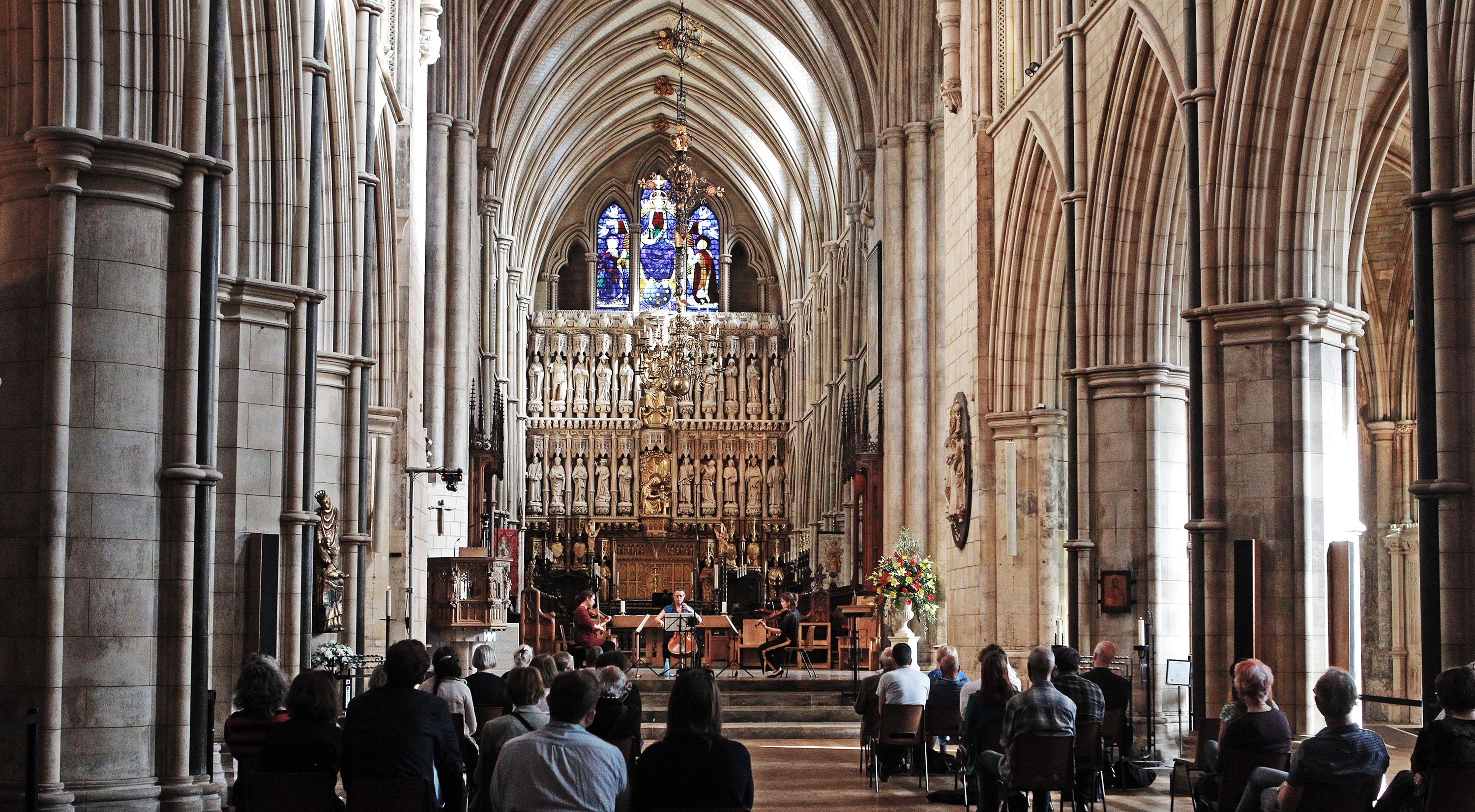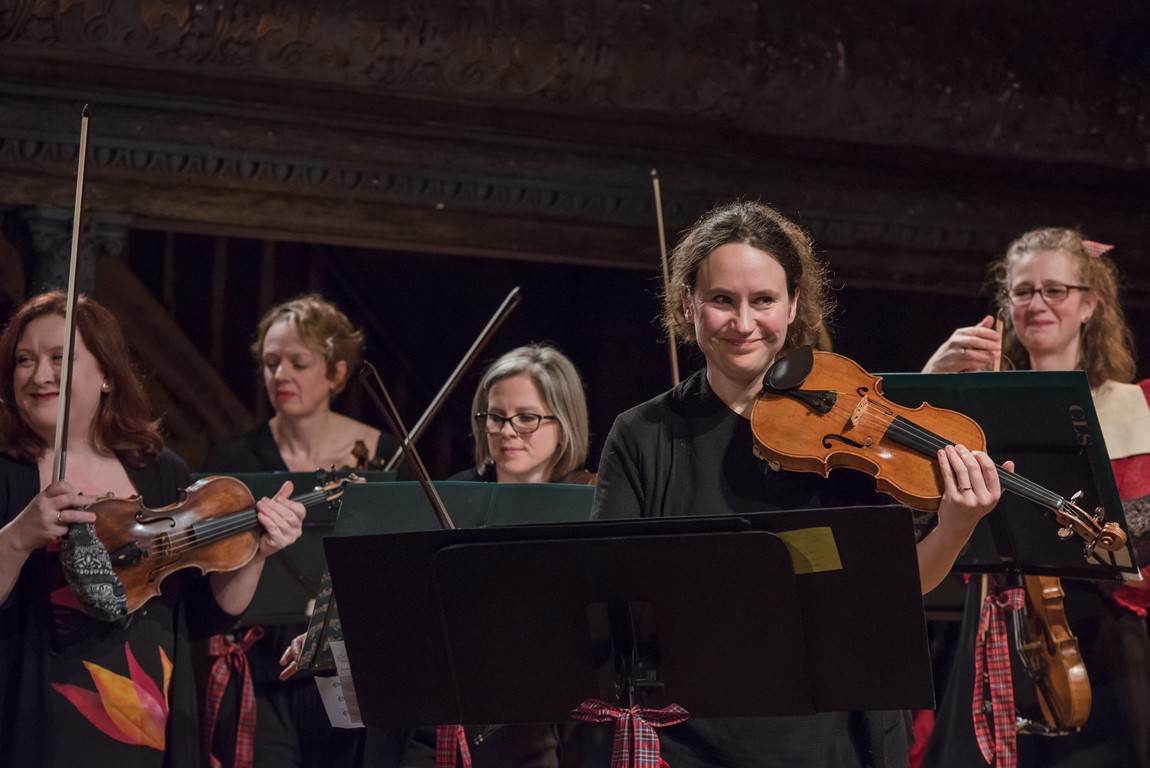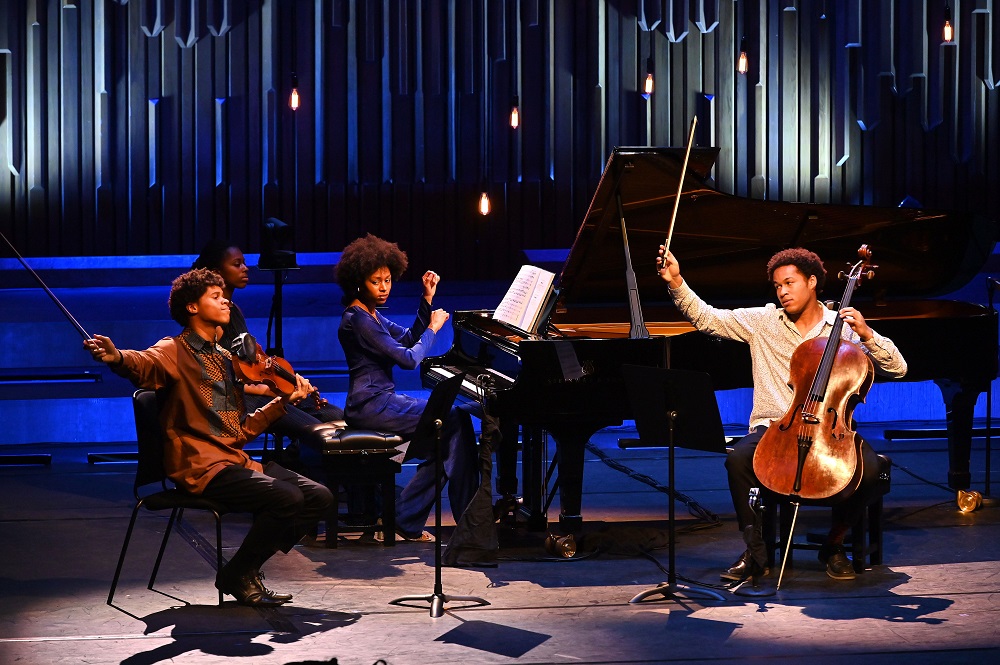City of London Sinfonia, Southwark Cathedral / Kanneh-Masons, Barbican review - soaring teamwork | reviews, news & interviews
City of London Sinfonia, Southwark Cathedral / Kanneh-Masons, Barbican review - soaring teamwork
City of London Sinfonia, Southwark Cathedral / Kanneh-Masons, Barbican review - soaring teamwork
The pure joy of music-making in both events, but with rigour and discipline

“Live music is back,” runs the Barbican's latest slogan, so treasure it and get out there while you can. Thursday evening in London offered an embarrassment of riches.
You could also have taken your pick, if you could get a ticket, between two pianists – Jonathan Plowright at the Wigmore Hall and Charles Owen at the Fidelio Orchestra Café – while the Academy of St Martin in the Fields Chamber Ensemble were playing Mozart and Beethoven at Kings Place’s Hall One and the Minerva Piano Trio had given a lunchtime recital at St John’s Smith Square.
Forgive the list, but it’s good to point out how the programming is almost like old times, albeit without big symphony orchestras and choirs. The gratitude and excitement seem equal on both sides: most soloists and ensembles are still playing in front of an audience for the first time since mid-March. Frissons even in a short mindfulness session from City of London Sinfonia violinist Ann Lovatt before the ensemble’s Serenades for Strings? Absolutely, when the players illustrated the magical intakes of breath which Elgar and Tchaikovsky use to introduce their slow movements. And standing on one leg with mental focus doesn’t seem at all daft when you then feel as listener how the body shifts weight from side to side in the performance, and how wonderful CLS leader and creative programmer Alexandra Wood used the physical freedom common to all the standing players (violins and violas; only the three cellists and the double-bass player sat. Pictured below by Marilyn Kingwill: the previous performance in Southwark Cathedral, a trio arrangement of Bach's Goldberg Variations).  There was the kind of personality in the interpretations you’d expect with a top conductor, and for that, especially in the space given to transitions and climaxes, Wood (pictured below) must take a lot of the credit. When I compared versions of the Tchaikovsky for BBC Radio 3’s Building a Library, there was a marked contrast between chamber orchestras and large symphonic string sections. The best of each proved equally viable, but here we had the virtues combined; Southwark Cathedral acoustics, far from muddying the sound, gave it extra depth and body.
There was the kind of personality in the interpretations you’d expect with a top conductor, and for that, especially in the space given to transitions and climaxes, Wood (pictured below) must take a lot of the credit. When I compared versions of the Tchaikovsky for BBC Radio 3’s Building a Library, there was a marked contrast between chamber orchestras and large symphonic string sections. The best of each proved equally viable, but here we had the virtues combined; Southwark Cathedral acoustics, far from muddying the sound, gave it extra depth and body.
The joy and tenderness of this great masterpiece could have been diffused by the space, but they weren’t, and the freedom to move around, which those who’d bought standing tickets used for a clockwise ambulatory around the fringes, came as an optional extra. The CLS has done a great deal to break down barriers in concert performance, but the essential rigour of live performance still remains.  So it does with the seven Kanneh-Mason siblings, who have too strong a grounding to ever turn into performing seals. Their Barbican programme was beautifully chosen: no single work lasting more than 15 minutes, but within the variety and range of solos and ensembles, plenty of depth as well as sheer chutzpah. It was canny to start with the single-movement C minor Piano Trio of the 16-year-old Shostakovich, the style already the composer we know, love and slightly fear in its nervous tension and chromatic unease; you’ve also got to love the way a sentimental melody finally joins the fray. There’s no doubt that Sheku will always be the top string player, a cellist in a thousand, but Braimah’s more ethereal violin has a poetic personality, too (pictured below, Braimah, left, with Isata and Sheku).
So it does with the seven Kanneh-Mason siblings, who have too strong a grounding to ever turn into performing seals. Their Barbican programme was beautifully chosen: no single work lasting more than 15 minutes, but within the variety and range of solos and ensembles, plenty of depth as well as sheer chutzpah. It was canny to start with the single-movement C minor Piano Trio of the 16-year-old Shostakovich, the style already the composer we know, love and slightly fear in its nervous tension and chromatic unease; you’ve also got to love the way a sentimental melody finally joins the fray. There’s no doubt that Sheku will always be the top string player, a cellist in a thousand, but Braimah’s more ethereal violin has a poetic personality, too (pictured below, Braimah, left, with Isata and Sheku).
That’s true of every real artist here. The three pianists – Isata, Jenaba and Konya – share a crystalline beauty of articulation which was as clear in Konya’s Schubert Impromptu (D899 No. 4 in A flat) as it was in Jeneba‘s (D935 No. 4 in F minor). Most bewitching to watch in action, with upwards glances akin to brother Sheku’s, was Isata in three Gershwin Preludes, cleverly chosen as movements to follow the opening of Barber’s Cello Sonata, with its typically turbulent piano writing; what a marvellously original piece. Of the full-ensemble arrangements, there was special magic in Simon Parkin‘s arrangement of Eric Whitacre's The Seal Lullaby, and the now-familiar family medley from a favourite film, Fiddler on the Roof, has its roots in the school klezmer band participation of four of the family members. The encore, similarly realised for the group by Sheku, Isata and Braimah on Sibelius software with other family members adding their contributions, was a mellow beauty brought to Bob Marley’s Liberation Song.  Full marks to the Barbican on presentation. The light show had been mastered before lockdown; the camera angles are various and impressive. Josie D’Arby’s sweet spirit shines through even if she keeps saying "Shoshtakovich"; I believe in her enthusiasm, which can’t be said for the gushers we’ve been subjected to in some other compering recently. The audience, only dimly visible at the end, were very audible in their support throughout. And I grinned my way through the streamed post-concert addition of questions and answers with the family, lovely parents Kadiatu and Stuart included. To watch, you had to sign up before the concert and then catch it within 48 hours, but I hope the whole thing will be available to all soon. This Von Trapp Family for our time must long remain an inspiration to all.
Full marks to the Barbican on presentation. The light show had been mastered before lockdown; the camera angles are various and impressive. Josie D’Arby’s sweet spirit shines through even if she keeps saying "Shoshtakovich"; I believe in her enthusiasm, which can’t be said for the gushers we’ve been subjected to in some other compering recently. The audience, only dimly visible at the end, were very audible in their support throughout. And I grinned my way through the streamed post-concert addition of questions and answers with the family, lovely parents Kadiatu and Stuart included. To watch, you had to sign up before the concert and then catch it within 48 hours, but I hope the whole thing will be available to all soon. This Von Trapp Family for our time must long remain an inspiration to all.
- CLS Goldberg Variations performance in Southwark Cathedral available to watch on YouTube until 30 October
- Next CLS concerts in Southwark Cathedral on 4 November
- Further events at the Barbican
- More classical music reviews on theartsdesk
rating
Explore topics
Share this article
The future of Arts Journalism
You can stop theartsdesk.com closing!
We urgently need financing to survive. Our fundraising drive has thus far raised £49,000 but we need to reach £100,000 or we will be forced to close. Please contribute here: https://gofund.me/c3f6033d
And if you can forward this information to anyone who might assist, we’d be grateful.

Subscribe to theartsdesk.com
Thank you for continuing to read our work on theartsdesk.com. For unlimited access to every article in its entirety, including our archive of more than 15,000 pieces, we're asking for £5 per month or £40 per year. We feel it's a very good deal, and hope you do too.
To take a subscription now simply click here.
And if you're looking for that extra gift for a friend or family member, why not treat them to a theartsdesk.com gift subscription?
more Classical music
 Jansen, LSO, Pappano, Barbican review - profound and bracing emotional workouts
Great soloist, conductor and orchestra take Britten and Shostakovich to the edge
Jansen, LSO, Pappano, Barbican review - profound and bracing emotional workouts
Great soloist, conductor and orchestra take Britten and Shostakovich to the edge
 Jakub Hrůša and Friends in Concert, Royal Opera review - fleshcreep in two uneven halves
Bartók kept short, and a sprawling Dvořák choral ballad done as well as it could be
Jakub Hrůša and Friends in Concert, Royal Opera review - fleshcreep in two uneven halves
Bartók kept short, and a sprawling Dvořák choral ballad done as well as it could be
 Hadelich, BBC Philharmonic, Storgårds, Bridgewater Hall, Manchester review - youth, fate and pain
Prokofiev in the hands of a fine violinist has surely never sounded better
Hadelich, BBC Philharmonic, Storgårds, Bridgewater Hall, Manchester review - youth, fate and pain
Prokofiev in the hands of a fine violinist has surely never sounded better
 Monteverdi Choir, ORR, Heras-Casado, St Martin-in-the-Fields review - flames of joy and sorrow
First-rate soloists, choir and orchestra unite in a blazing Mozart Requiem
Monteverdi Choir, ORR, Heras-Casado, St Martin-in-the-Fields review - flames of joy and sorrow
First-rate soloists, choir and orchestra unite in a blazing Mozart Requiem
 Cho, LSO, Pappano, Barbican review - finely-focused stormy weather
Chameleonic Seong-Jin Cho is a match for the fine-tuning of the LSO’s Chief Conductor
Cho, LSO, Pappano, Barbican review - finely-focused stormy weather
Chameleonic Seong-Jin Cho is a match for the fine-tuning of the LSO’s Chief Conductor
 Classical CDs: Shrouds, silhouettes and superstition
Cello concertos, choral collections and a stunning tribute to a contemporary giant
Classical CDs: Shrouds, silhouettes and superstition
Cello concertos, choral collections and a stunning tribute to a contemporary giant
 Appl, Levickis, Wigmore Hall review - fun to the fore in cabaret and show songs
A relaxed evening of light-hearted fare, with the accordion offering unusual colours
Appl, Levickis, Wigmore Hall review - fun to the fore in cabaret and show songs
A relaxed evening of light-hearted fare, with the accordion offering unusual colours
 Lammermuir Festival 2025, Part 2 review - from the soaringly sublime to the zoologically ridiculous
Bigger than ever, and the quality remains astonishingly high
Lammermuir Festival 2025, Part 2 review - from the soaringly sublime to the zoologically ridiculous
Bigger than ever, and the quality remains astonishingly high
 BBC Proms: Ehnes, Sinfonia of London, Wilson review - aspects of love
Sensuous Ravel, and bittersweet Bernstein, on an amorous evening
BBC Proms: Ehnes, Sinfonia of London, Wilson review - aspects of love
Sensuous Ravel, and bittersweet Bernstein, on an amorous evening
 Presteigne Festival 2025 review - new music is centre stage in the Welsh Marches
Music by 30 living composers, with Eleanor Alberga topping the bill
Presteigne Festival 2025 review - new music is centre stage in the Welsh Marches
Music by 30 living composers, with Eleanor Alberga topping the bill
 Lammermuir Festival 2025 review - music with soul from the heart of East Lothian
Baroque splendour, and chamber-ensemble drama, amid history-haunted lands
Lammermuir Festival 2025 review - music with soul from the heart of East Lothian
Baroque splendour, and chamber-ensemble drama, amid history-haunted lands
 BBC Proms: Steinbacher, RPO, Petrenko / Sternath, BBCSO, Oramo review - double-bill mixed bag
Young pianist shines in Grieg but Bliss’s portentous cantata disappoints
BBC Proms: Steinbacher, RPO, Petrenko / Sternath, BBCSO, Oramo review - double-bill mixed bag
Young pianist shines in Grieg but Bliss’s portentous cantata disappoints

Add comment